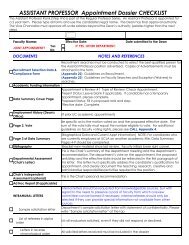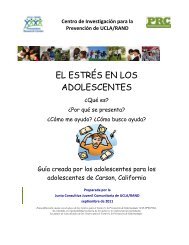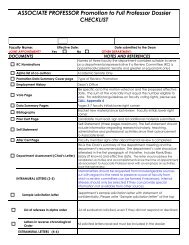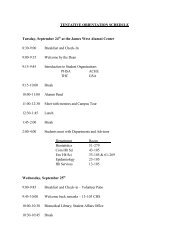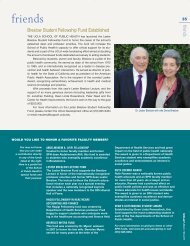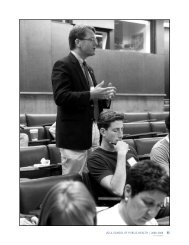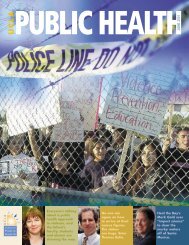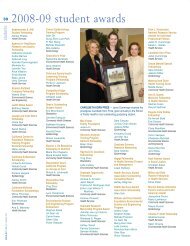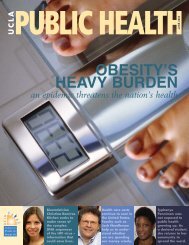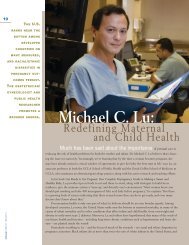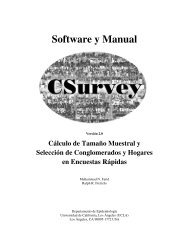Anne Pebley: - UCLA School of Public Health
Anne Pebley: - UCLA School of Public Health
Anne Pebley: - UCLA School of Public Health
You also want an ePaper? Increase the reach of your titles
YUMPU automatically turns print PDFs into web optimized ePapers that Google loves.
8<br />
POPULATION<br />
DEMOGRAPHER<br />
EXAMINES THE<br />
EFFECT OF SOCIAL<br />
AND POLITICAL<br />
FORCES ON<br />
INDIVIDUAL<br />
BEHAVIOR AND<br />
WELL-BEING — AND<br />
STUDIES WAYS TO<br />
ENSURE POSITIVE<br />
CONDITIONS.<br />
<strong>Anne</strong> <strong>Pebley</strong>:<br />
Big Thinking for Local Change<br />
The online version <strong>of</strong> Merriam-Webster’s Collegiate Dictionary defines<br />
demography as “the statistical study <strong>of</strong> human populations especially with reference to size and density,<br />
distribution, and vital statistics” – which, to the uninitiated, may seem at odds with the study <strong>of</strong> neighborhood<br />
conditions and their influence on individual behaviors and health outcomes. But Dr. <strong>Anne</strong> <strong>Pebley</strong> views<br />
her role as director <strong>of</strong> the Los Angeles Family and Neighborhood Survey (LA FANS) as perfectly consistent<br />
with her expertise as a demographer and holder <strong>of</strong> the endowed Fred H. Bixby Chair at the <strong>UCLA</strong> <strong>School</strong><br />
<strong>of</strong> <strong>Public</strong> <strong>Health</strong>.<br />
<strong>UCLA</strong>PUBLIC HEALTH<br />
LA FANS is an analysis by RAND and <strong>UCLA</strong> researchers <strong>of</strong> 65 neighborhoods in L.A. County, focusing<br />
on the impact <strong>of</strong> the surrounding environment on children’s health, social development, school performance,<br />
stress and other variables. The first wave <strong>of</strong> the survey was recently completed and the data are being analyzed.<br />
The research stems from a widely held view that neighborhoods are where social interventions should<br />
occur. “The idea is that if you’re trying to improve the life <strong>of</strong> one child at a time, you might not have as<br />
much impact as if you change the environment in which the child lives,” <strong>Pebley</strong> explains. The movement<br />
afoot in Los Angeles to create neighborhood councils and service planning areas raises questions that are<br />
being addressed by <strong>Pebley</strong>’s team: What defines a neighborhood? What impact does improving the immediate<br />
environment have on residents? What specific improvements have the most impact, and what aspects<br />
<strong>of</strong> well-being do they affect? “Understanding these issues is crucial to cost-effective policy intervention,”<br />
<strong>Pebley</strong> asserts.
LA FANS examines terrain that is at the heart<br />
<strong>of</strong> <strong>Pebley</strong>’s research interest, which is focused on<br />
the effect <strong>of</strong> the social and political environment on<br />
individual behavior and well-being. “Individuals are<br />
not isolated, despite the feeling you might get from<br />
the ideology prevalent in the United States,” she<br />
says, smiling. “The environment in which we function<br />
may have a much bigger impact than we typically<br />
would like to think on our behavior and on<br />
our health – economic, mental and physical.”<br />
Indeed, <strong>Pebley</strong> explains, to view demography<br />
only through the lens <strong>of</strong> global trends is to miss<br />
the drivers <strong>of</strong> those trends. “I’m interested in what’s<br />
going on at the macro level,” she says. “But if you<br />
want to understand the process that leads to population<br />
growth and change, you have to also conduct<br />
research at the micro level.”<br />
<strong>Pebley</strong>’s career course was launched in graduate<br />
school at Cornell University, where she enrolled in<br />
a master’s degree program in international development.<br />
The focus was on agricultural economics,<br />
nutrition and demography <strong>of</strong> population; the last<br />
captured her interest, particularly at a time – the<br />
1970s – when population growth rates in poor<br />
countries were at unprecedented levels. “It seemed<br />
to me you had to understand these underlying<br />
demographic processes if you wanted to make any<br />
difference in the world,” she recalls. In a career that<br />
has taken her to a number <strong>of</strong> countries in Latin<br />
America, Asia and Africa to conduct her studies,<br />
<strong>Pebley</strong>’s interests have diverged toward related<br />
issues, including children’s health. One major focus<br />
<strong>of</strong> her work has been on social and political determinants<br />
<strong>of</strong> health behaviors and outcomes in developing<br />
countries. <strong>Pebley</strong> continues to publish results <strong>of</strong><br />
research she started in rural Guatemala in 1990 on<br />
how parents and expectant mothers decide among<br />
health care providers – ranging from biomedical pr<strong>of</strong>essionals<br />
to the more traditional providers common<br />
in the indigenous villages – for pediatric and reproductive<br />
care. The research has captured the interest<br />
<strong>of</strong> the country’s Ministry <strong>of</strong> <strong>Health</strong>. “If pregnant<br />
women in these communities are going to midwives<br />
rather than physicians, as a policy-maker you want<br />
your focus to be on providing the best possible<br />
training for midwives,” <strong>Pebley</strong> explains.<br />
After 14 years on the faculty at Princeton<br />
University and six as director <strong>of</strong> the Population<br />
Research Center and senior sociologist at RAND,<br />
she joined the full-time faculty at the <strong>UCLA</strong> <strong>School</strong><br />
<strong>of</strong> <strong>Public</strong> <strong>Health</strong> in 1999 as pr<strong>of</strong>essor and Fred H.<br />
Bixby Chair. The endowed chair supports research,<br />
teaching and service in the population field. Last<br />
year, the foundation gave a large new gift to the<br />
school that helped establish the Fred H. Bixby<br />
Program in Population. “The Bixby Program is critical<br />
to our goal <strong>of</strong> expanding research, training and<br />
service in the areas <strong>of</strong> family planning, reproductive<br />
health and population,” says <strong>Pebley</strong>, who serves as<br />
chair <strong>of</strong> the program’s steering committee. “We are<br />
very grateful for the fund’s continuing support.”<br />
In 1998, just before being named to the Bixby<br />
Chair, <strong>Pebley</strong> served as president <strong>of</strong> the Population<br />
Association <strong>of</strong> America, the national pr<strong>of</strong>essional<br />
organization for demographers, sociologists, economists,<br />
public health pr<strong>of</strong>essionals and others interested<br />
in research and education in the population<br />
field. That year she delivered an address on a topic<br />
that was receiving little attention among her peers:<br />
the relationship between population policy and<br />
environmental consequences. Concern about the<br />
environment had moved to the periphery <strong>of</strong> demographic<br />
research ever since the 1960s, when many<br />
were predicting that rapid population growth would<br />
soon lead humans to exhaust natural resources and<br />
face environmental collapse. <strong>Pebley</strong>’s warning <strong>of</strong> the<br />
potential impact on health and mortality <strong>of</strong> environmental<br />
change – from global warming and air pollution<br />
to land-use trends – is now being heeded by<br />
a growing number <strong>of</strong> researchers.<br />
<strong>Pebley</strong> conveys that message to <strong>UCLA</strong> students<br />
each fall in her sought-after Population Change<br />
and <strong>Public</strong> Policy course. “I love teaching that<br />
course, because it forces me to stay up to date on<br />
what’s going on, and to think about these issues,”<br />
says <strong>Pebley</strong>, who was honored by the <strong>Public</strong> <strong>Health</strong><br />
Students Association as Pr<strong>of</strong>essor <strong>of</strong> the Year for<br />
the Department <strong>of</strong> Community <strong>Health</strong> Sciences in<br />
2002. Being around students – particularly given<br />
the diversity <strong>of</strong> backgrounds and experiences <strong>of</strong><br />
the <strong>School</strong> <strong>of</strong> <strong>Public</strong> <strong>Health</strong>’s – is invigorating, she<br />
says. “They think about things in ways I never have.<br />
I always learn a lot from them.”<br />
For <strong>Pebley</strong>, the ability to constantly learn about<br />
matters <strong>of</strong> concern to her is half <strong>of</strong> what makes<br />
her work rewarding; the other half is the knowledge<br />
that what she learns can be used to improve people’s<br />
lives. “I guess you could say that, like most<br />
people in academia, I am infinitely curious,” she<br />
says. “Researchers have a tremendous luxury in the<br />
sense that we can, to a certain extent, follow our<br />
interests. But at the same time, when I work with<br />
people in the community through my research and<br />
volunteering, I am reminded that these are real<br />
issues affecting real people, that we don’t have a<br />
lot <strong>of</strong> money to spend on public policy and we have<br />
to be very strategic in how we spend it. I would like<br />
to think that what I do has a positive impact in<br />
guiding such decisions.”<br />
“Individuals<br />
are not<br />
isolated. The<br />
environment<br />
in which we<br />
function may<br />
have a much<br />
bigger impact<br />
than we typically<br />
would like<br />
to think on our<br />
behavior and<br />
on our health.”<br />
—Dr. <strong>Anne</strong> <strong>Pebley</strong><br />
9<br />
faculty pr<strong>of</strong>ile <strong>UCLA</strong>PUBLIC HEALTH



